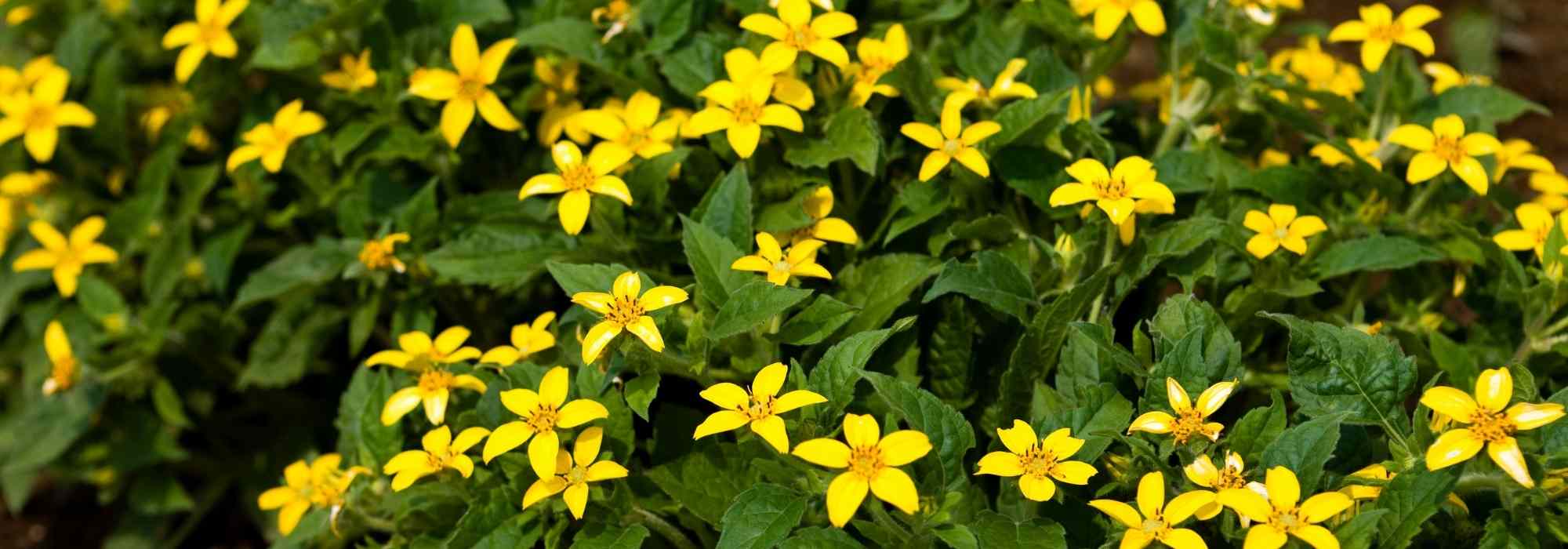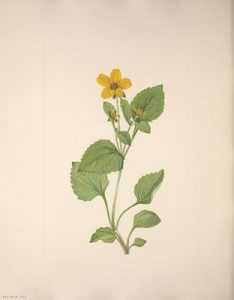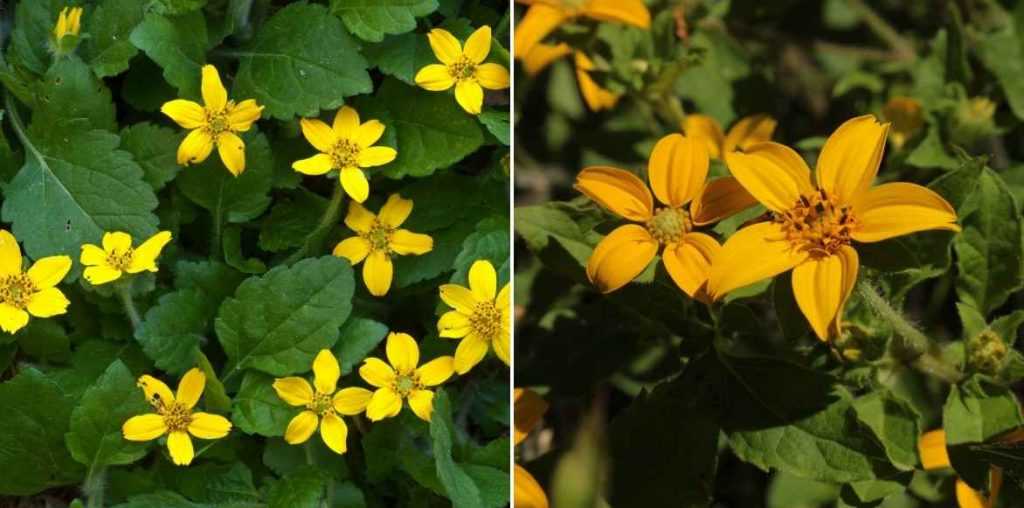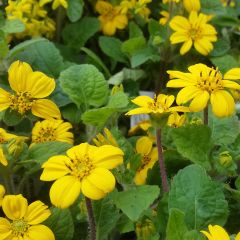
Chrysogonum : planting, growing, and care
Contents
Chrysogonum in a nutshell
- This is a hardy perennial groundcover that thrives in cool, dappled shade
- It forms tapetums of green, downy leaves topped with small golden-yellow star-shaped flowers
- It blooms from May until All Saints’ Day
- It is hardy, easy to grow, and requires no maintenance
- It is perfect for borders, slopes, or rockeries that are not too dry
The word from our expert
The Chrysogonum, also known as “Golden Knee,” is an excellent yet lesser-known groundcover plant that thrives in light shade. It is perfect for shady and cool corners of the garden. It forms mats of deciduous leaves, about 40 cm tall, topped with small, radiant yellow flowers. It captivates with its endless and particularly abundant flowering from late spring until autumn. The most common in our gardens and the only one of its genus is the Chrysogonum virginianum and its lovely cultivar, the Chrysogonum virginianum ‘André Viette’.
Easy to grow, hardy in all climates, low-maintenance, and non-invasive, this small perennial thrives in any good garden soil, well-drained and remaining cool in summer. This plant will also adapt to a non-scorching sunny spot.
Chrysogonum is a true treasure for cool rockeries, shady slopes, areas near water features, the edges of perennial beds, or light and cool woodland settings.
If you’re looking for a highly floriferous and carpeting perennial, don’t miss our Chrysogonum!
Description and botany
Botanical data
- Latin name Chrysogonum
- Family Asteraceae
- Common name Golden knee
- Flowering May to November
- Height 0.25 to 0.30 cm
- Exposure Sun, Partial shade, Shade
- Soil type Rich, moist, well-drained
- Hardiness -15 °C and below
Chrysogonum, also known as “Golden knee,” is a perennial ground cover plant belonging to the Asteraceae family, much like daisies, asters, or sunflowers. The genus includes only one species, Chrysogonum virginianum, native to the fresh woodlands of the eastern United States. It has given rise to a few varieties and a more compact, widely cultivated cultivar, ‘André Viette’.

Chrysogonum virginianum, botanical plate, circa 1925
This creeping and stoloniferous perennial plant spreads to form a dense ground cover thanks to its long underground rootstocks. They root to create a more or less compact vegetative mat, 25-30 cm in height, spreading at least 40-50 cm. Chrysogonum spreads slowly without ever becoming invasive. This mat-forming clump, taller than it is wide, is deciduous, disappearing with the cold and reappearing in spring.
The reddish-green aerial stems, short and upright, are pubescent and highly branched. They bear prominent nodes from which the pedicels emerge, their shape reminiscent of a knee, hence the nickname ‘Golden knee’ given to the plant.
They develop small deciduous leaves, bright green in colour, opposite, oblong, 3 to 10 cm long. Hairy and slightly crinkled, with crenate or dentate margins and prominent veins, they resemble those of lemon balm in our gardens.
With its slightly pubescent texture, this foliage serves as a backdrop to the generous flowering of Chrysogonum. It begins in May and continues uninterrupted until the first frosts. Star-shaped flowers in solitary heads emerge from this verdant mass, in the axils of the upper leaves. They bloom as pure yellow daisies, 2 to 4 cm in diameter. They consist of a row of five broad, rounded ray florets radiating around a central disc with more or less visible yellow pistils. They have a pleated appearance and are slightly fringed at their tips.
These sun-like flowers later produce seeds that self-sow easily, ensuring the plant’s longevity and allowing it to naturalise in the garden.

Chrysogonum flowers and foliage
Species and varieties

Chrysogonum virginianum André Viette
- Flowering time June to December
- Height at maturity 25 cm

Chrysogonum virginianum
- Flowering time June to December
- Height at maturity 30 cm
Discover other Chrysogonum
View all →Available in 1 sizes
Available in 1 sizes
Planting Chrysogonum
Where to Plant It?
A bit slow to establish, Chrysogonum takes about two years to fully fill out, though flowering occurs as early as the first year of cultivation. Over time, it forms small, very floriferous clumps. Perfectly hardy (down to -23°C), it thrives in most gardens across our regions. Preferring moist soils over arid ones and intolerant of water shortages, it dislikes very dry summers, making cultivation tricky in Mediterranean climates.
As for soil, it adapts to any light, well-draining, humus-bearing, or even peaty soil, retaining freshness and moisture, especially in summer. Highly adaptable, once well-rooted, it can tolerate temporarily waterlogged or occasionally dry soil.
In a location with non-scorching sun or light shade, and cool in summer, it will form clumps that expand over time but remain easy to control. It can also thrive in deeper shade. Avoid planting it near trees and bushes, as it dislikes root competition.
Non-invasive, take advantage of its unique ground-cover qualities to enhance a cool, shaded rockery, a pathway border, a shady slope, the edges of a water feature, to edge a perennial bed, or brighten a lightly shaded woodland edge. It’s an excellent plant for beautifying the north side of a house. It also works well to cover the base of a rose bush.
When to Plant It?
Planting takes place in spring, from February to April, or in autumn, from September to November, avoiding frost and extreme heat.
How to Plant It?
Space the young plants about 40 cm apart and allow for 5 plants per square metre to create a dense ground cover. Add gravel to improve drainage if needed.
- Dig a planting hole 2 to 3 times wider than the root ball
- Place the plant in the centre of the hole
- Fill with a mix of good potting compost, garden soil, and a handful of compost
- Firm the soil
- Water regularly to encourage establishment
→ Check out our tips for planting perennials successfully!

Chrysogonum virginianum and Stachys thunbergii (© Peganum)
Maintenance and Care
Hardy and vigorous, Chrysogonum virginianum requires almost no care once well established.
It prefers soil that does not dry out too much in summer. It needs sufficient moisture at the base, especially in summer or if rainfall is scarce. Ensure you water it regularly during the first year of cultivation, then once or twice a week during hot spells. It can tolerate temporary drought once well rooted. A mulch (straw, leaves, etc.) spread over the stump to limit evaporation will help.
If your soil is poor, adding compost at its base in spring will be beneficial.
Remove faded flowers to encourage the development of new ones.
In autumn or late winter, pull out excess leafy stolons to control the plant’s spread. Divide clumps every 2-3 years to keep them vigorous.
Chrysogonum virginianum is never diseased and is unaffected by parasitic attacks. However, in spring, follow our advice to protect its young foliage from slugs and snails.
Multiplication
Chrysogonum naturalises easily thanks to its underground rootstocks and self-sowing. If you have harvested its seeds at ripeness, you can sow them in buckets or trays in spring, placing them in a cold frame. Dividing clumps in spring before flowering or in early autumn is easier to achieve. To propagate it, you can also simply separate runners and replant them immediately in the garden in moist soil.
Division
- With a garden fork, lift a portion of the stump
- Divide it into several sections, each with roots and a start of leaves
- Replant immediately in the ground and monitor watering to ensure good recovery
Pair
The Chrysogonum virginianum is an interesting ground cover to brighten up cool, shaded areas of a garden with its long, sunny flowering. It pairs well with perennials that thrive in cool soil and partial shade. It fits effortlessly into a natural garden or water gardens.
It thrives in cool but not waterlogged soil along the banks of ponds or water features, alongside the Ligularia dentata ‘Dark Beauty’ with its yellow-orange flowers and the Carex elata ‘Aurea’ for a very luminous composition.
Arums, hostas, meadowsweets, Virginia bluebells, and hardy geraniums such as the hardy geranium ‘Bob’s Blunder’ and the hardy geranium ‘Gravetye’ will also make excellent companions.

A cool-soil association featuring Chrysogonum, Tradescantia, Ligularia dentata, and some beautiful hostas
It can also accompany summer flowers in non-scorching sunlight, provided the soil remains cool. It can be used to fill gaps in a perennial border alongside Knautia, masterworts, or blue phlox like the Phlox divaricata ‘Chattahoochee’. It can also adorn the base of roses alongside other ground cover perennials, such as Heucherellas like Heucherella ‘Stoplight’ with its yellow to lime-green foliage and creeping Bugles.
→ Discover more ideas for pairing with Chrysogonum with Virginie’s tips!
Useful resources
- What are the best plants to grow under trees
- Subscribe!
- Contents

































Comments